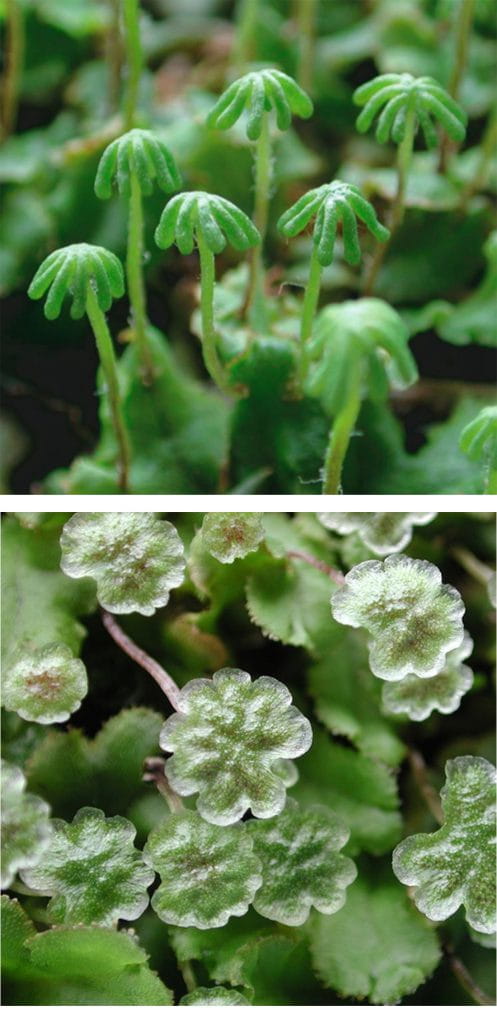Research summary
Research outline
We are interested in resilient plant development in response to ever-changing environment, which is one of the characteristics of plants, and aim to elucidate the underlying regulatory strategies and mechanisms of cell proliferation and differentiation control. We aim to conduct our research across the genetic, molecular, cellular, individual, and ecosystem levels, focusing on molecular genetic analysis. The laboratory focuses on the land plant evolution and promote the use of the liverwort Marchantia polymorpha as a model. We are conducting the following research.

- Light perception and signal transduction in plants
Light is an environmental factor that has strong impact on plant growth. Our research aims to elucidate the mechanisms of light regulation from photoreceptors to physiological responses in plants. As known as the law of photochemistry, only light absorbed by a substance is involved in its reaction. Light is absorbed by photoreceptors to be recognized by living organisms, and photoreceptors are key molecules that convert light, which is a physical signal, into biological information. Organisms can then sense light information such as light intensity, light quality (wavelength), light direction, and the duration and timing of light exposure, and can respond appropriately to the light conditions of their habitat. Taking advantage of the fact that M. polymorpha possess only one molecular species each of the plant photoreceptors phytochrome, cryptochrome, and phototropin, we aim to elucidate the mechanism by which plants respond appropriately to the light environment through the cooperation of light photoreceptors. In particular, research focusing on phytochrome is ongoing. In the case of M. polymorpha, one molecular species of phytochrome is responsible for the different modes of actions, while in the case of angiosperms, the roles are separated into different molecular species. We expect that a detailed molecular anatomical study of the phytochrome molecule in M. polymorpha will help to elucidate the mechanism of phytochrome signal transduction. - Environmental regulation of plant growth and development
Plants accurately sense seasonal fluctuations and optimize their events in the life cycle. Among them, induction of sexual reproduction program, such as flowering, is a key to the survival and diversity of the next generation. The identification of key factors of these controls has been analyzed mainly in Arabidopsis thaliana, a model flowering plant. Flowering is controlled by organogenesis in the sporophyte generation, which is a diploid phase 2n. In bryophytes, the formation of cells in the germline from apices that grow vegetatively in the gametophyte generation, which is a haploid phase n, is the first step to induce sexual reproduction. We found that the response mechanism to shift the developmental program by the environment, such as day length and light quality, is conserved during land plant evolution. We previously identified the transcription factor BONOBO as a key factor in determining germ cell lineage. We are studying the environment-dependent regulation of BONOBO gene expression and analyzing the function of target genes regulated by the BONOBO gene. - Sex determination and differentiation in a haploid system
Sex determination and sex differentiation are important for organisms to advance sexual reproduction. However, the mechanism of sex determination is extremely diverse among organisms. In many organisms, sex determination occurs in the diploid generation, but in some organisms, such as bryophytes, sex is determined in the haploid generation. We focused on the fact that liverworts have sex chromosomes and sex determination occurs in the haploid generation, and identified a sex-determination gene, Feminizer, from M. polymorpha. This is the first achievement in elucidating sex determination and sex chromosome evolution in the haploid systems. We are currently developing research focusing on the chromatin state of the autosomal sex-determining locus under the control of Feminizer. Surprisingly, we also found a gametolog of Feminizer in the male sex chromosome, which has the function of inducing sexual reproduction in common with the gametolog on each sex chromosome. We are now analyzing the functions of the Feminizer and its gametolog, which will provide insight into the establishment and evolution of sex determinants and sex chromosomes. - Evolution of plant hormone signaling
Genome analyses conducted by the international collaborations including this laboratory have yielded many insights relevant to plant evolution. We found that most regulatory systems were established around the time of the emergence of land plants. For example, the biosynthetic enzymes, receptors, and signal transducers for the major plant hormone auxin were completed as a set with the emergence of land plants. We also found that M. polymorpha have few gene duplications, making them suitable for elucidating the principles of regulation. On the other hand, some hormones such as jasmonic acid and ethylene have also been shown the precursors physiologically active, although they lack the active molecules of the angiosperms. Currently, we are focusing on gibberellins, which have been shown to biosynthesized in a light-dependent manner, and to be involved in growth and sexual reproduction.
Main themes
- Light perception and signal transduction in plants
- Sex determination and differentiation in a haploid system
- Environmental regulation of chromatin status
- Evolution of plant hormone signaling
Member
|
KOHCHI, TakayukiProfessor |
tkohchi*lif.kyoto-u.ac.jp See faculty information |
|---|---|
|
YASUI, YukikoAssociate Professor |
yasui.yukiko.7a*kyoto-u.ac.jp See faculty information |
|
YOSHITAKE, YoshihiroAssistant Professor |
yoshitake.yoshihiro.7v*kyoto-u.ac.jp See faculty information |
- Please note that the @ symbol has been replaced by *.
Access
North Campus, Graduate School of Biostudies Bldg.



